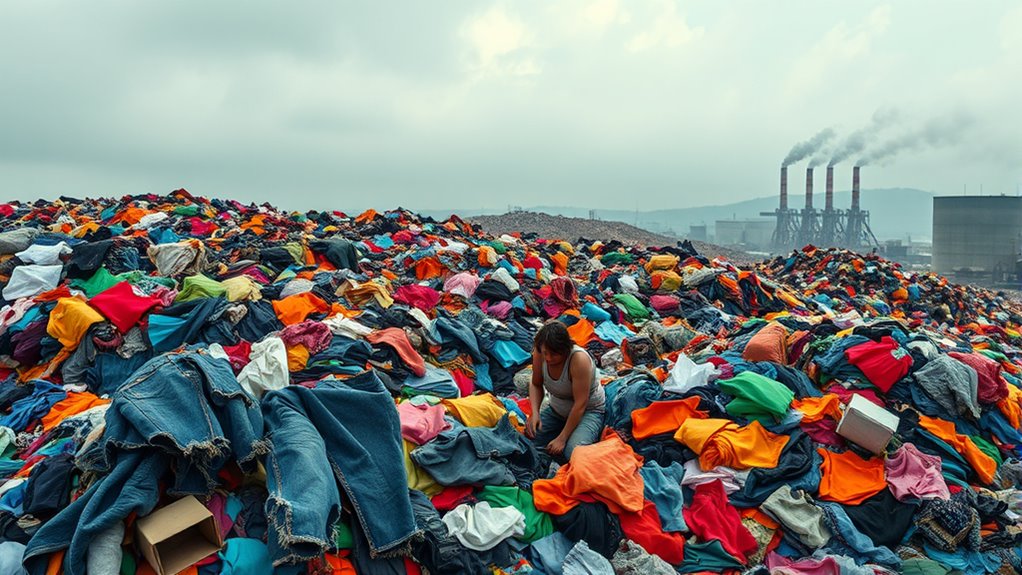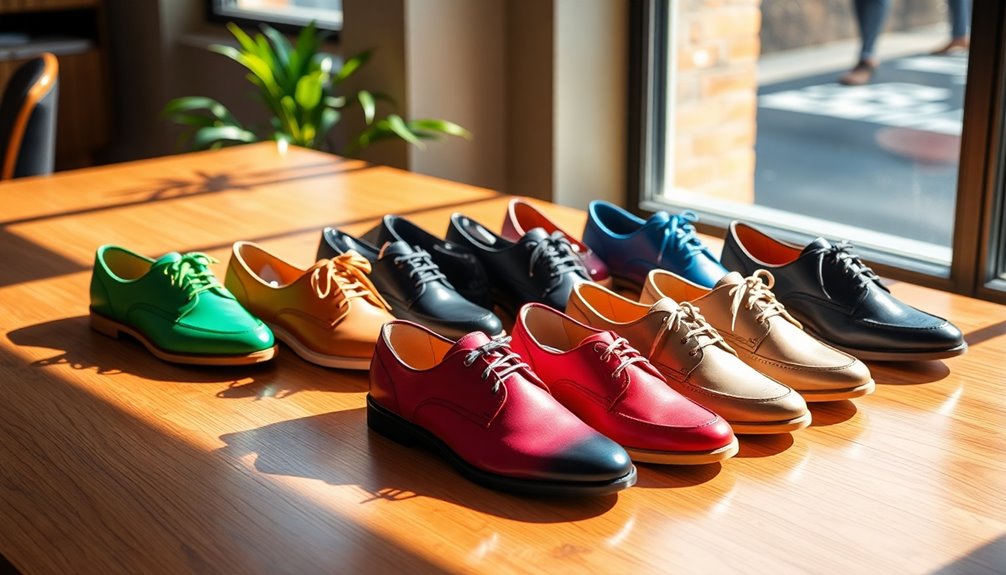Fast fashion offers trendy clothes at low prices, but it comes with hidden costs. It damages the environment through water waste, pollution, and microplastics. It also exploits workers with unsafe conditions and unfair wages. This business model encourages constant shopping and quickly discarded garments, worsening waste and pollution. Choosing sustainable fashion supports better practices, reduces environmental harm, and promotes ethical treatment of workers. Stay with us to discover how you can make smarter, more eco-friendly choices in your wardrobe.
Key Takeaways
- Fast fashion’s resource-intensive production causes significant environmental damage, including water waste, pollution, and microplastic pollution.
- It exploits workers through low wages and unsafe conditions, raising ethical concerns.
- Rapid turnover and low-quality materials lead to short-lived garments, increasing waste and landfill overflow.
- Supporting sustainable fashion reduces ecological harm, promotes fair labor practices, and encourages longer-lasting, high-quality clothing.
- The shift toward circular, eco-friendly designs helps mitigate fast fashion’s environmental and social impacts.
The Environmental Impact of Fast Fashion

Have you ever considered how quickly fast fashion’s cheap, trendy clothes end up harming the environment? When you buy from fast fashion brands, you’re supporting a system that relies on massive resource consumption. These companies use huge amounts of water, often wasting it during production, and rely heavily on synthetic fibers like polyester, which shed microplastics into oceans. The production process also releases harmful chemicals into the air and water, polluting ecosystems. Additionally, since clothes are made cheaply, they’re often discarded after just a few wears, fueling overflowing landfills. Fast fashion’s rapid turnover leads to overproduction, creating enormous waste and carbon emissions that contribute to climate change. Your buying choices directly impact the planet’s health, highlighting the urgent need for more sustainable alternatives.
The Human Cost Behind Cheap Clothing

Behind every cheap, trendy piece of clothing lies a story of exploitation and hardship for millions of workers. Many are paid meager wages and forced to work long hours in unsafe conditions. You may not see their struggles, but they’re directly linked to what you wear. Workers often endure poor ventilation, hazardous chemicals, and physical abuse to produce fast fashion. Additionally, the floating on water practices in some manufacturing areas can contribute to environmental degradation, further impacting vulnerable communities. The use of essential oils in manufacturing processes can sometimes mask or mitigate the harmful effects of chemical exposure on workers. Recognizing the second trimester period of pregnancy can encourage consumers to consider the ethical implications of their choices during important life stages. Understanding the vibrational energy behind sustainable practices can inspire more conscious purchasing decisions. Moreover, adopting eco-friendly materials can significantly reduce the environmental footprint of fashion production.
The Fast Fashion Business Model and Its Flaws
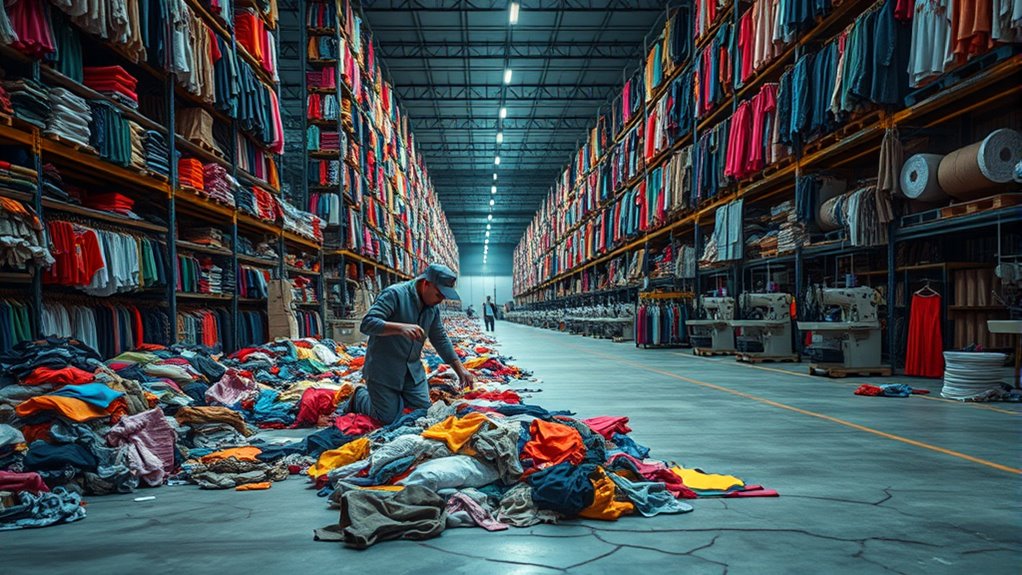
Fast fashion’s quick production cycles mean new styles hit the shelves almost weekly, encouraging you to buy more often. These brands often use low-quality materials that wear out quickly, forcing you to replace items sooner. This cycle fuels waste and harms the environment, revealing flaws in the business model. Additionally, many fast fashion companies lack ethical sourcing practices, which exacerbates environmental and social issues. The reliance on cheap labor in developing countries often leads to poor working conditions and exploitation.
Rapid Production Cycles
Why do clothing collections seem to change so rapidly? It’s all about fast fashion’s obsession with quick turnaround times. Brands rush to produce new styles, often sacrificing quality and ethics. They use rapid production cycles to keep pace with trends and consumer demands. This approach results in new collections hitting stores every few weeks, encouraging constant shopping. Additionally, the pressure to stay ahead in the fashion industry often leads to unsustainable practices, which further exacerbate environmental and social issues. The fast-paced nature of this industry also contributes to increased waste, as discarded garments pile up due to their short lifespan. Furthermore, the reliance on cheap materials and shortcuts in manufacturing processes intensifies the environmental footprint of fast fashion.
Low-Quality Materials
Clothing made with low-quality materials is a hallmark of the fast fashion business model, designed to keep costs and production times down. These cheap fabrics often degrade quickly, leading to garments that fall apart after just a few wears. You might notice that a trendy top or pair of jeans loses its shape, color, or texture much sooner than expected. Fast fashion brands prioritize speed and affordability over durability, so they use synthetic fibers like polyester, which are cheaper but environmentally harmful. This short lifespan encourages you to buy more often, fueling a cycle of constant consumption. Instead of investing in well-made, sustainable pieces, you’re encouraged to replace low-quality items frequently, increasing waste and environmental damage. Additionally, the reliance on cheap fabrics contributes to increased microplastic pollution in our waterways.
The Role of Consumer Demand in Fast Fashion Growth
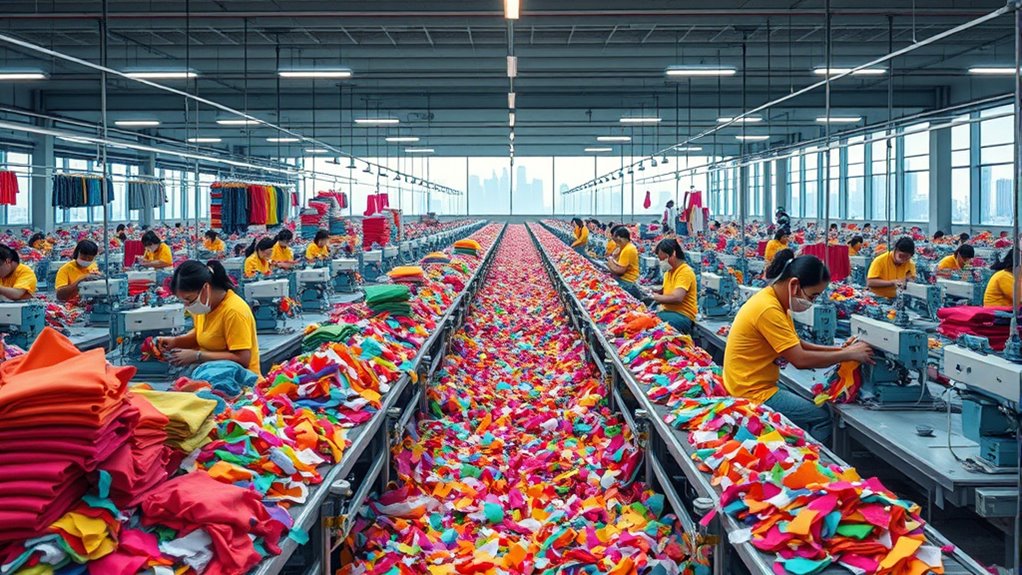
Consumer demand plays a crucial role in driving the rapid expansion of fast fashion. When you constantly seek new styles at low prices, brands respond by producing more, faster. Your desire for trendy, affordable clothing pushes companies to prioritize quick turnaround times over quality or sustainability. This cycle fuels mass production and waste, as styles quickly become outdated. To see this impact, consider this table:
| Consumer Behavior | Fast Fashion Response | Environmental Impact |
|---|---|---|
| Want latest trends | Rapid stock updates | Overproduction waste |
| Seek affordability | Low-cost manufacturing | Increased pollution |
| Value variety | Frequent new releases | Higher landfill waste |
| Impulse buying | Limited quality items | Resource depletion |
| Follow influencers | Quick trend adoption | Carbon footprint rise |
Additionally, the supply chain practices of fast fashion brands often contribute to environmental degradation through unsustainable resource extraction and waste management. The production processes involved frequently lack transparency, exacerbating ecological harm and social issues. Furthermore, the fast fashion industry’s emphasis on rapid turnover leads to increased carbon emissions and water usage, intensifying ecological strain. Moreover, the environmental impacts of these practices include significant pollution and habitat destruction, which further endanger ecosystems and biodiversity. Recognizing the importance of sustainable materials, many companies are now exploring eco-friendly alternatives to reduce their ecological footprint.
Benefits of Choosing Sustainable Fashion

By choosing sustainable fashion, you help reduce environmental harm caused by waste and pollution. You’re also supporting fair labor practices that guarantee workers are treated ethically and paid fairly. Making these choices benefits both the planet and the people behind your clothes. Additionally, selecting clothing made with eco-friendly materials can decrease reliance on resource-intensive processes like AI-powered virtual reality in e-learning manufacturing, further reducing your carbon footprint. Incorporating sustainable textile production techniques can also minimize water and energy consumption, comfort solutions for clothing, and promote the use of innovative dyeing methods that lessen chemical use, thereby amplifying the positive impact of your choices.
Environmental Impact Reduction
Have you ever considered how your fashion choices can substantially reduce environmental harm? Choosing sustainable fashion can make a real difference. First, it cuts down on waste by encouraging durable, high-quality pieces that last longer. Second, it reduces pollution because sustainable brands use eco-friendly dyes and processes that emit fewer toxins. Third, it conserves resources like water and energy, since eco-conscious manufacturers prioritize efficiency and renewable sources. Additionally, glycolic acid products can help improve skin health, highlighting the importance of mindful product choices in a sustainable lifestyle. By opting for sustainable fashion, you help lower carbon footprints and decrease the strain on the planet’s ecosystems. Every mindful purchase contributes to a cleaner environment and promotes a more responsible industry. Your choices have power—embracing sustainable fashion helps protect natural resources and reduces the negative impact of fast fashion on our planet.
Supporting Ethical Labor
Did you know that choosing sustainable fashion directly supports fair treatment and safe working conditions for laborers? When you opt for ethical brands, you’re ensuring workers receive fair wages, proper safety measures, and respectful treatment. This not only improves lives but also promotes transparency in supply chains. Supporting ethical labor helps create a more equitable fashion industry that values people over profits. Additionally, transparency in supply chains can be enhanced through ethical sourcing practices, ensuring consumers are aware of the origins of their clothing. Incorporating Gold IRA rollovers into your retirement planning can be part of a diversified strategy to secure long-term financial stability. Consider the table below, which shows the benefits of supporting ethical labor:
| Fair Wages | Safe Conditions | Respectful Treatment |
|---|---|---|
| Better quality of life | Reduced workplace accidents | Promotes dignity |
| Economic stability | Lower risk of exploitation | Fosters trust |
| Community growth | Healthier work environments | Empowers workers |
How to Identify and Support Ethical Brands

Wondering how to tell if a brand truly cares about ethical practices? Start by researching their transparency—do they openly share their supply chain info? Next, look for certifications like Fair Trade or B Corp, which validate ethical standards. Finally, evaluate their commitment beyond marketing—do they support fair wages, safe working conditions, and environmental responsibility? Additionally, examining a brand’s use of sustainable materials and their efforts in reducing environmental impact can offer further insight into their ethical commitments. Being aware of supply chain transparency helps consumers make informed choices and encourages brands to prioritize ethical practices.
Practical Tips for Building a Sustainable Wardrobe
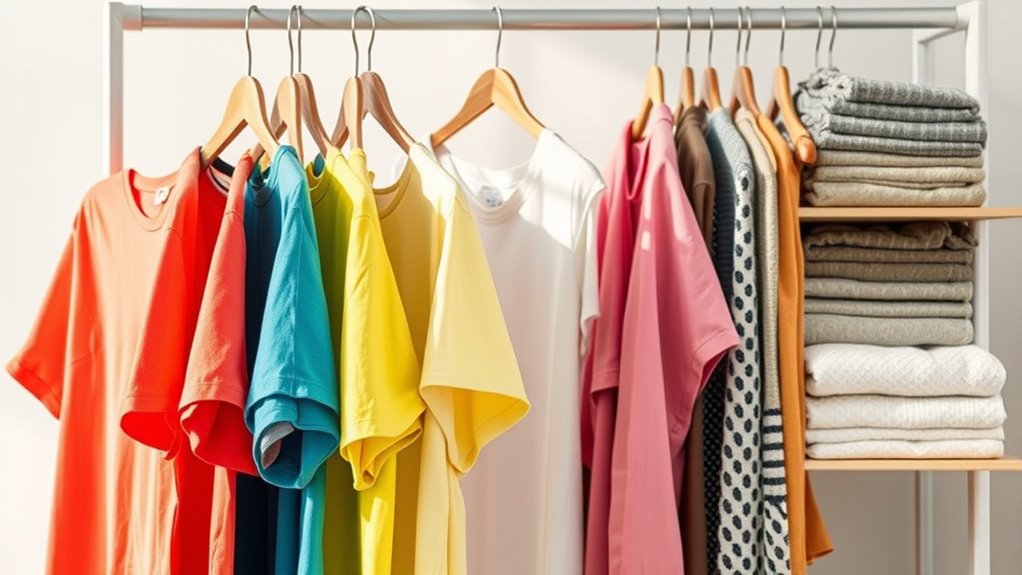
Building a sustainable wardrobe starts with making intentional choices about the pieces you bring in. Focus on quality over quantity—buy fewer, better-made items that will last longer. Before purchasing, ask yourself if you’ll genuinely wear the piece often and if it aligns with your values. Opt for timeless styles rather than fleeting trends to reduce waste. Consider shopping secondhand or at thrift stores to give clothes a second life. Take good care of your garments by following washing instructions and repairing minor damages promptly. Limit impulsive buys by creating a wardrobe checklist or plan. Remember, building sustainability isn’t about perfection but making smarter, more conscious decisions that reduce your environmental impact. Small changes can lead to a more eco-friendly, ethical wardrobe over time.
The Future of Fashion: Trends Toward Sustainability
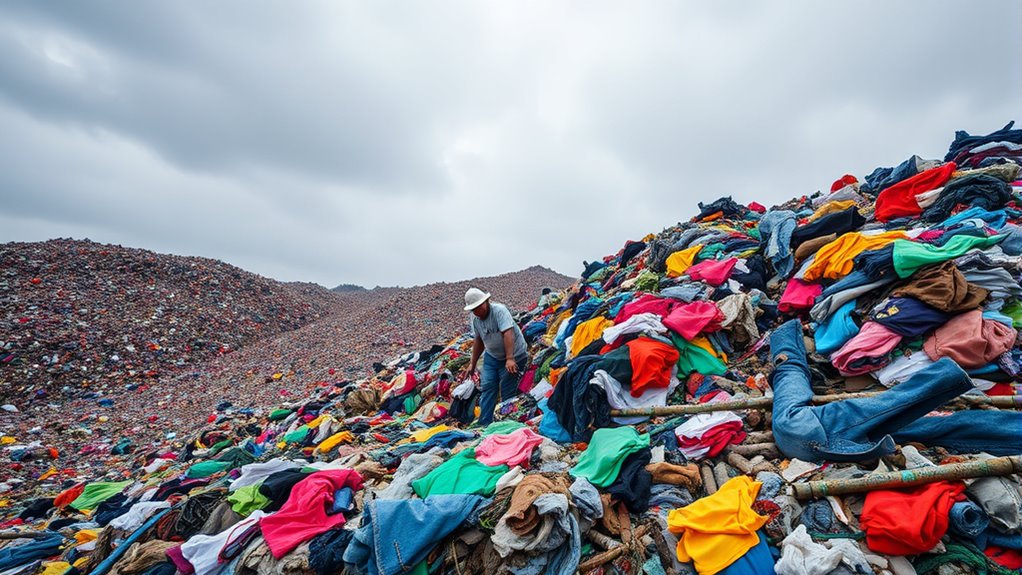
As awareness of environmental issues grows, the fashion industry is increasingly shifting toward sustainable practices. This shift is shaping the future of fashion, emphasizing eco-friendly innovations and responsible consumption. You’ll see brands adopting circular design, where clothes are made to be reused, repurposed, or recycled. Transparency becomes a priority, with companies sharing their supply chain details to build trust. Additionally, technological advances like biodegradable fabrics and digital sampling reduce waste and resource use. To understand this better, consider these trends:
The fashion industry is embracing sustainability through circular design, eco-friendly materials, and greater transparency.
- Embracing circular economy models to minimize waste
- Investing in eco-friendly materials and innovative fabrics
- Increasing transparency to foster consumer trust and accountability
These changes aim to create a more sustainable, ethical fashion landscape that aligns with your values and supports a healthier planet.
Making a Difference: Small Steps for Big Change

Even small actions can lead to significant environmental benefits when it comes to sustainable fashion. You don’t need to overhaul your entire wardrobe overnight. Simple steps, like choosing quality over quantity, can reduce waste and extend the life of your clothes. Opt for clothes made from eco-friendly materials and support brands committed to ethical practices. Repairing or repurposing your garments instead of discarding them also makes a big difference. Being mindful of how often you shop and avoiding fast fashion outlets helps reduce demand for environmentally damaging production. Sharing your knowledge with friends and encouraging them to make sustainable choices amplifies your impact. Every conscious decision, no matter how small, contributes to a healthier planet and a more sustainable fashion industry.
Frequently Asked Questions
How Does Fast Fashion Affect Global Water Resources?
Fast fashion considerably impacts global water resources because it relies on water-intensive production processes. When you buy fast fashion, you’re supporting companies that use vast amounts of water to grow textiles like cotton and dye fabrics. This depletes local water supplies, harms ecosystems, and causes pollution through wastewater discharge. Your choices can help reduce water waste; opting for sustainable brands helps conserve this essential resource for communities and the environment.
What Are the Long-Term Health Effects of Toxic Dyes in Clothing?
You might not realize it, but wearing clothes with toxic dyes can have serious long-term health effects. Exposure to these chemicals can cause skin irritation, allergies, and even more severe issues like hormonal imbalances or respiratory problems over time. By choosing sustainably dyed clothing, you help reduce your risk and protect your health. Making informed choices supports a safer environment for everyone, including yourself.
How Does Fast Fashion Influence Local Economies and Communities?
You might think fast fashion boosts local economies, but it often harms them long-term. When you buy cheaply made clothing, local artisans and small businesses struggle to compete with mass-produced items from overseas. This can lead to job losses and economic decline in communities that rely on traditional craftsmanship. By supporting sustainable fashion, you help preserve local industries, create fair jobs, and foster a healthier, more resilient economy.
Can Sustainable Fashion Be Affordable for Everyone?
You might wonder if sustainable fashion can be affordable for everyone. The truth is, it can be, if you choose wisely. Many brands now offer eco-friendly options at competitive prices, and buying secondhand or during sales helps reduce costs. By supporting local artisans and smaller brands, you often find unique, quality pieces that don’t break the bank. With mindful shopping, sustainable fashion becomes accessible and affordable for all.
What Policies Can Governments Implement to Curb Fast Fashion?
Your government can make a huge difference by implementing stricter regulations on fast fashion brands, like limiting their waste and chemical use. They could also impose higher taxes on overproduction and incentivize sustainable practices through grants or subsidies. Enforcing transparency in supply chains helps consumers make informed choices. These policies act like a shield, protecting the environment and workers, and encouraging the fashion industry to shift toward sustainability.
Conclusion
Just like Icarus flying too close to the sun, chasing fast fashion’s quick fixes can lead to a fall. But by choosing sustainable brands and making mindful choices, you can help rewrite the story—one where fashion doesn’t come at Earth’s expense. Remember, every small step you take echoes like a ripple in a pond, shaping a future where style and sustainability soar together. Your choices matter more than you think; be the change you want to see.
